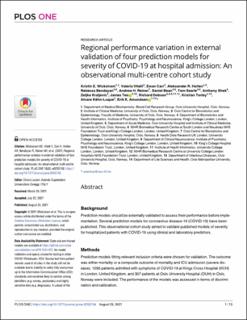| dc.contributor.author | Wickstrøm, Kristin E. | |
| dc.contributor.author | Vitelli, Valeria | |
| dc.contributor.author | Carr, Ewan | |
| dc.contributor.author | Holten, Aleksander R. | |
| dc.contributor.author | Bendayan, Rebecca | |
| dc.contributor.author | Reiner, Andrew H. | |
| dc.contributor.author | Bean, Daniel | |
| dc.contributor.author | Searle, Tom | |
| dc.contributor.author | Shek, Anthony | |
| dc.contributor.author | Kraljevic, Zeljko | |
| dc.contributor.author | Teo, James | |
| dc.contributor.author | Dobson, Richard | |
| dc.contributor.author | Tonby, Kristian | |
| dc.contributor.author | Köhn-Luque, Alvaro | |
| dc.contributor.author | Amundsen, Erik K. | |
| dc.date.accessioned | 2021-10-15T19:05:06Z | |
| dc.date.available | 2021-10-15T19:05:06Z | |
| dc.date.created | 2021-09-15T16:13:53Z | |
| dc.date.issued | 2021-08-25 | |
| dc.identifier.citation | PLOS ONE. 2021, 16 (8), 1-13. | en_US |
| dc.identifier.issn | 1932-6203 | |
| dc.identifier.uri | https://hdl.handle.net/11250/2823466 | |
| dc.description.abstract | Background: Prediction models should be externally validated to assess their performance before implementation. Several prediction models for coronavirus disease-19 (COVID-19) have been published. This observational cohort study aimed to validate published models of severity for hospitalized patients with COVID-19 using clinical and laboratory predictors. Methods: Prediction models fitting relevant inclusion criteria were chosen for validation. The outcome was either mortality or a composite outcome of mortality and ICU admission (severe disease). 1295 patients admitted with symptoms of COVID-19 at Kings Cross Hospital (KCH) in London, United Kingdom, and 307 patients at Oslo University Hospital (OUH) in Oslo, Norway were included. The performance of the models was assessed in terms of discrimination and calibration. Results: We identified two models for prediction of mortality (referred to as Xie and Zhang1) and two models for prediction of severe disease (Allenbach and Zhang2). The performance of the models was variable. For prediction of mortality Xie had good discrimination at OUH with an area under the receiver-operating characteristic (AUROC) 0.87 [95% confidence interval (CI) 0.79–0.95] and acceptable discrimination at KCH, AUROC 0.79 [0.76–0.82]. In prediction of severe disease, Allenbach had acceptable discrimination (OUH AUROC 0.81 [0.74–0.88] and KCH AUROC 0.72 [0.68–0.75]). The Zhang models had moderate to poor discrimination. Initial calibration was poor for all models but improved with recalibration. Conclusions: The performance of the four prediction models was variable. The Xie model had the best discrimination for mortality, while the Allenbach model had acceptable results for prediction of severe disease. | en_US |
| dc.description.sponsorship | One of the authors (JTHT) have previously received research support and funding from InnovateUL, Bristol-Myers-Squibb, iRhytm Technologies, and hold shares under £5000 in Glaxo SmithKline and Biogen. | en_US |
| dc.language.iso | eng | en_US |
| dc.publisher | Public Library of Science | en_US |
| dc.relation.ispartofseries | PLOS ONE;16 (8): e0255748 | |
| dc.rights | Navngivelse 4.0 Internasjonal | * |
| dc.rights.uri | http://creativecommons.org/licenses/by/4.0/deed.no | * |
| dc.subject | Forecasting | en_US |
| dc.subject | COVID-19 | en_US |
| dc.subject | Intensive care units | en_US |
| dc.subject | Virus testing | en_US |
| dc.subject | Lymphocytes | en_US |
| dc.subject | Oxygen | en_US |
| dc.subject | Clinical laboratories | en_US |
| dc.title | Regional performance variation in external validation of four prediction models for severity of COVID-19 at hospital admission: An observational multi-centre cohort study | en_US |
| dc.type | Peer reviewed | en_US |
| dc.type | Journal article | en_US |
| dc.description.version | publishedVersion | en_US |
| dc.rights.holder | © 2021 Wickstrøm et al. | en_US |
| dc.source.articlenumber | e0255748 | en_US |
| cristin.ispublished | true | |
| cristin.fulltext | original | |
| cristin.qualitycode | 1 | |
| dc.identifier.doi | https://doi.org/10.1371/journal.pone.0255748 | |
| dc.identifier.cristin | 1934650 | |
| dc.source.journal | PLOS ONE | en_US |
| dc.source.volume | 16 | en_US |
| dc.source.issue | 8 | en_US |
| dc.source.pagenumber | 1-13 | en_US |

